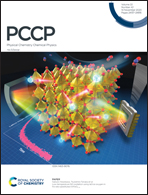Strain-driven surface reconstruction and cation segregation in layered Li(Ni1−x−yMnxCoy)O2 (NMC) cathode materials†
Abstract
The composition, structure and phase transformations occurring on cathode surfaces greatly affect the performance of Li-ion batteries. Li-Ion diffusion and surface–electrolyte interaction are two major phenomena that impact the capacity and cell impedance. The effects of surface reconstruction (SR) of cathode materials on the performance of Li-ion batteries are of current interest. However, the origin and evolution of the SR are still not well understood. In this work, density functional theory (DFT) calculations are used to investigate the processes taking place during surface segregation and reconstruction. Facet dependent segregation was found in Li(Ni1−x−yMnxCoy)O2 (NMC) cathodes. Specifically, Co tends to segregate to the (104) surface of the primary particles within the transition metal layer, while Ni ions tend to segregate to the (012) surface in the Li layer, forming a SR. Experimental evidence shows the SR to be epitaxial with the bulk of the as-synthesized material, and the new SR phase is pinned to the NMC unit cell leading to a strained SR. Here, we show that strain can stabilize a spinel structure of the SR layers. Understanding the effects of surface strain opens a new avenue for the design of cathode materials with enhanced surface properties.



 Please wait while we load your content...
Please wait while we load your content...